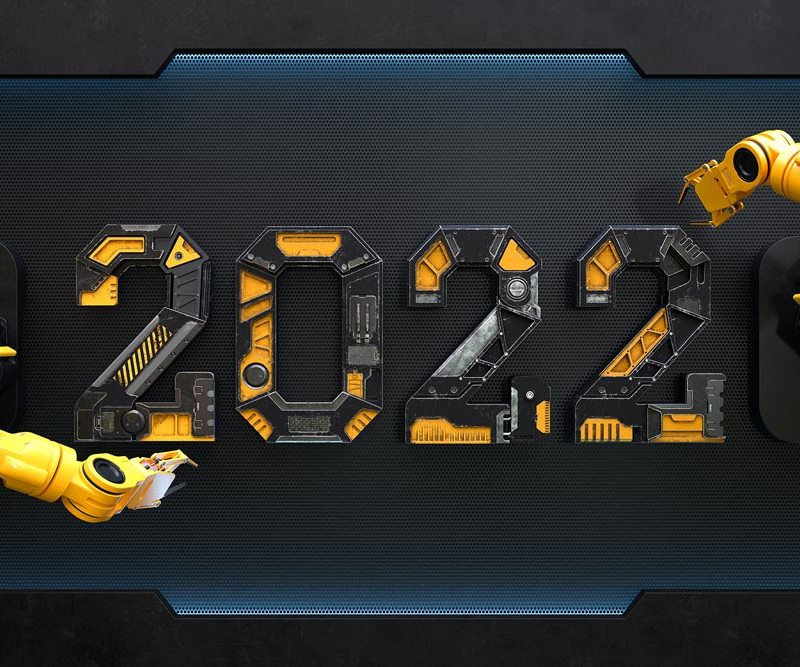2022 – The Year of Automation
Everyone is fed up of hearing about the pandemic and the catastrophic impact it has had on the world. But the fact is, although statistics confirm Covid-19 is waning, the rise of new variants including Omicron means the virus is still very much present and working its way through the population, continuing to leave its destruction behind it.
This, combined with the effects of Brexit, have dragged UK businesses into unknown territory in a ‘sink or swim’ style scenario. Many businesses have folded, thousands of jobs have been lost, but there is an upside to this – many have managed to ride the wave and come out the other side with a stronger, more resilient business model that will drive them forward despite uncertain times.
One industry that has benefitted from this adversity is the automation industry, with Covid-19 driving companies to accelerate their plans to incorporate intralogistics automation and robotics into their business in a bid to protect themselves from further disruption.
So, what have we learned from our experiences of 2021 and how can we use this foresight to drive us into a new, future-proofed era in automation? Here Dr Paul Rivers, CEO of Guidance Automation, looks back at lessons learned and outlines his predictions for 2022 and beyond.
This year we have seen intralogistics automation and Autonomous Mobile Robots (AMRs) become fairly commonplace, whether through choice or necessity as awareness of its benefits have grown. In our 2021 research to explore the importance of intralogistics automation within companies that have a warehouse, fulfilment, production or distribution operation, we found that 25% of companies we surveyed said the pandemic had accelerated their plans to deploy automation with three quarters planning to invest in the next 12 months. Last year saw a steady adoption of automation pace, however, this was not due to increased demand – but actually in response to the operational challenges businesses have been facing. These include staff shortages, social distancing requirements, delivery issues as well as material and equipment shortages.
Air and sea freight were the first to feel the effects of Covid-19 due to the enforcement of strict travel restrictions; this was then exacerbated by the lack of HGV drivers able to deliver goods and of course vital manufacturing components have also been in short supply due to factories shutting down or working at reduced output.
Further, the pandemic has seen many businesses transitioning to a more flexible, remote working model with employees being given the opportunity to work partly at home. This has created further problems for employers as workers can now consider remote opportunities further afield, making the employee market even more challenging. The addition of strict social distancing guidelines has also caused its own considerable issues to include a 2m separation between employees, zoning of areas, increased sanitation facilities, staggered and complex shift and break patterns, an increase in personal equipment and extra break areas, entrances and exits.
It’s a minefield of requirements and hurdles to overcome and part of the reason why so many logistics and manufacturing businesses in particular have embraced automation last year. However, the results of our survey prove automation has benefitted workers too and has helped shift their often negative perspective to a more positive outlook that has helped businesses make change more quickly and successfully.
Just over half (54%) of businesses believe automation has had a positive impact on warehouse and manufacturing plant employees including less repetitive and strenuous manual work (49%), offering workers the chance to upskill (39%) and by reducing the reliance on physical picking activity, flexibility within the business is increased providing relief for overworked staff (40%).
It’s clear that we have learned much during the past 12 months. 2021 was a year of change, struggle and innovation with UK businesses becoming less risk-averse, more technologically savvy and better equipped to survive the uncertainties of this year. So, what does 2022 hold for these industries?
UK businesses are reaching a more comfortable position where there is some knowledge of the added requirements and challenges of running a business during and after a pandemic. This means they are able to make clearer decisions with confidence. The manufacturing and logistics landscape has changed irrevocably and businesses must adapt accordingly to ensure they keep pace with industry and their competitors. Here are five reasons why global automation will shape business moving forward:
Moving up the business agenda
Our industry survey found that 73% of those surveyed believed automation to be business-critical moving forward. Automation is beginning to reach the board room table, reaching the C-suite who are now embracing automation having realised its potential for driving their business forward. In their Predictions 2022 blog, Forrester summarises it in a nutshell, predicting that those fully embracing automation –will ‘obliterate – not merely beat – the competition’.
Creation of a global automation platform
In recognition of this new, elevated positioning, Automation technology providers whether in the RPA, BPA or AI space are vying to create a unified, enterprise-wide platform that combines technology, robot and human data and processes taking the global, industrial automation market to the next level. This is not surprising, considering its market value – according to Statista, the automation industry is estimated to be worth $207bn by 2022 with the UK taking a $2bn share of this.
Leading the way with AMRs in 2022
The logistics industry in particular, has been predicted to be the fastest growing sector for Automated Mobile Robots (AMRs) and Automated Guided Vehicles (AGVs) in 2022. Common drivers for this are rising costs and the acute labour shortage – there are 2.5 million logistics roles in the UK, many of which remain unfilled. Wages are therefore driven up and accompanied by the need for flexible manufacturing in line with market conditions. Research by Interact Analysis shows that robotics and software products accounted for 51% of all new product launches in 2021 with piece picking robots predicted to have an annual growth rate of 90% by 2025. This is not surprising considering the continued pressure on supply chains to guarantee next-day or same-day delivery in response to a sharp shift towards e-commerce over the past 18 months.
Addressing the workforce deficit
The worker shortage we are currently enduring will be here for a while yet, with many industry critics believing it will actually get worse before it improves. Service-led roles and manual roles including warehouse jobs will be harder to fill due to their physically intensive nature and lower wage, therefore more and more companies will invest in automation to address this. At least 35% of service companies will introduce physical robot workers, altering the manual worker landscape forever. This advanced hybrid workforce model will get the best out of the human and the robot relationship, using resources more efficiently, speeding up workflow while reducing human error. The most advanced robot workers – referred to as ‘Cobots’, that is, collaborative robots, work in partnership with humans, often within a shared space. These Cobots have superior enabling technologies such as machine intelligence, increased performance capabilities and superior mobility and we will hear more and more about these moving into next year as word spreads of the business improvements they, in partnership with human workers can offer.
Increased demand for commercial premises
Although the home-working model will continue as a successful format to operate within, many industries including manufacturing and logistics require employees to work from a central location. This will undoubtedly have a lasting impact on workspace design with future layouts being considerably different from those pre-pandemic formats. This in turn, will inevitably impact on demand for commercial premises and drive up prices in future years. The jury is still out on what this new format will look like but undoubtedly it will continue to evolve over the next five years as we learn to work within a changeable environment.
Conclusion
It’s clear that 2022 will be a year of significant innovation with automation rising to the top of the business agenda. We are undoubtedly entering a new era, one that is irreversible – we are set on a path of automation to not only protect ourselves from continued adversity but because it makes sound business sense for the future.
There are still many hurdles ahead but if we can negotiate these, businesses can be confident they can endure another pandemic with structure and defence. But what of those that are reticent to join the journey towards automation? Well, if Forrester is right, they will fall behind while those adopting these advancements will soar.
To find out more about how autonomous mobile robots can help within your business contact Guidance Automation today:
Call us on: +44 116 243 6250
Alternatively: Fill out the form on our contact page




